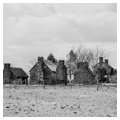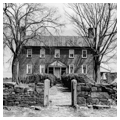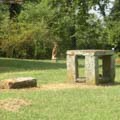Tobacco barns, once ubiquitous in Southside and the southern Piedmont, are fast disappearing. In the past, farmers in every Southside and southern Piedmont county raised tobacco, but now large growers have acquired almost exclusive domain over Virginia's most famous “weed.” This crop, which first supplied Virginia plantation owners and then multitudes of small farmers with their livelihood, is losing ground.
During the colonial period, virtually all tobacco was air-cured, until the smoky-flavored dark tobacco was developed in the first half of the nineteenth century. Dark tobacco is cured by the smoke of several smoldering fires on the dirt floor of tall, gable-roofed windowless tobacco barns almost always made of log. At ground level, they have U-shaped stone flues with openings flanking the barn's one small door. Inside, tier poles support rows of tobacco hung on sticks (see CP9). Usually there was also a pack house, a simple enclosed building, often heated, that could serve various purposes in addition to providing storage for cured tobacco until it could be graded and prepared for market.
Around the third quarter of the nineteenth century, a new flue-cured method for producing sweet bright-leaf tobacco was perfected. Bright tobacco grows best in the thin, sandy soil of western Southside near South Boston, the southern Piedmont, and in neighboring North Carolina. It, too, was cured in tall log structures, but the fires for curing it were in stone fireboxes, or furnaces, that prevented the tobacco from taking a smoky flavor. Gable or roof vents or, later, metal flues provided ventilation. Usually there was a shed roof attached to the tobacco barn that provided shelter for the workers.
A third type of tobacco, burley, is grown in the richer soil of Southwest Virginia and farther west. Like colonial-era tobacco, it is air-dried. The burley tobacco barns of Southwest Virginia tend to be less specialized, sometimes with open slats, but are always open enough to let air circulate. New methods of processing tobacco have made all of these old tobacco barns obsolete. Their place has been taken by modern metal containers that look like giant shoe boxes.
Writing Credits
If SAH Archipedia has been useful to you, please consider supporting it.
SAH Archipedia tells the story of the United States through its buildings, landscapes, and cities. This freely available resource empowers the public with authoritative knowledge that deepens their understanding and appreciation of the built environment. But the Society of Architectural Historians, which created SAH Archipedia with University of Virginia Press, needs your support to maintain the high-caliber research, writing, photography, cartography, editing, design, and programming that make SAH Archipedia a trusted online resource available to all who value the history of place, heritage tourism, and learning.




